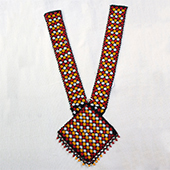Design Resource
Bead Weaving - Ahmedabad, Gujarat
Technique of beadwork
by
Prof. Bibhudutta Baral and Rakshitha
Bead weaving is a traditional art made in the combination of colorful beads and colorful threads that gel along aesthetically. Using seed beads the artisan elaborately embellish garments. Some of the other products made by seed beads weaving are listed below:
• Belts
• Key Chains
• Door Garlands (Toran)
• Jewelleries like:
- Necklaces
- Earrings
- Bracelets
- Long Chains
- Anklets
- Headbands
- Armlets, etc.












